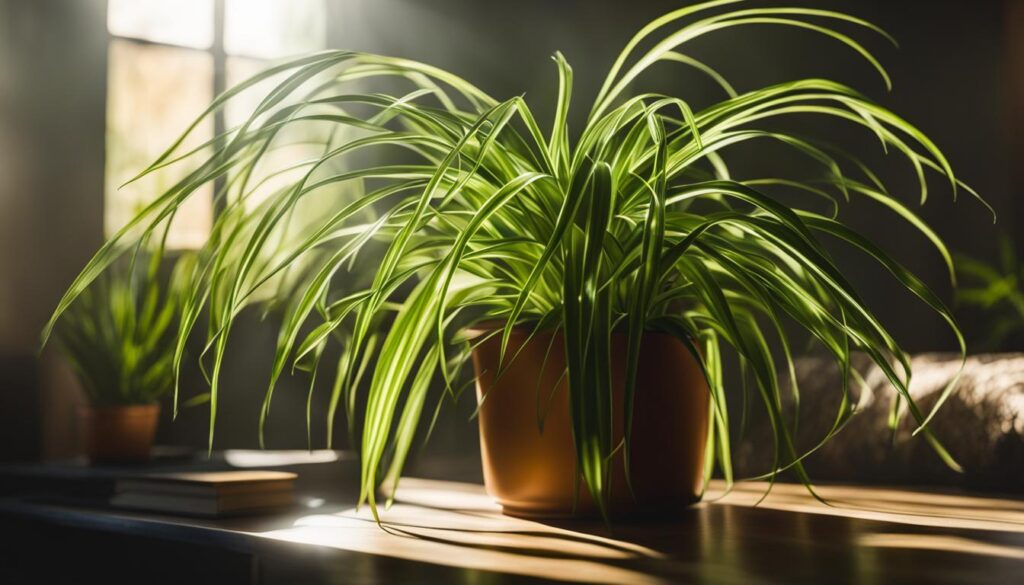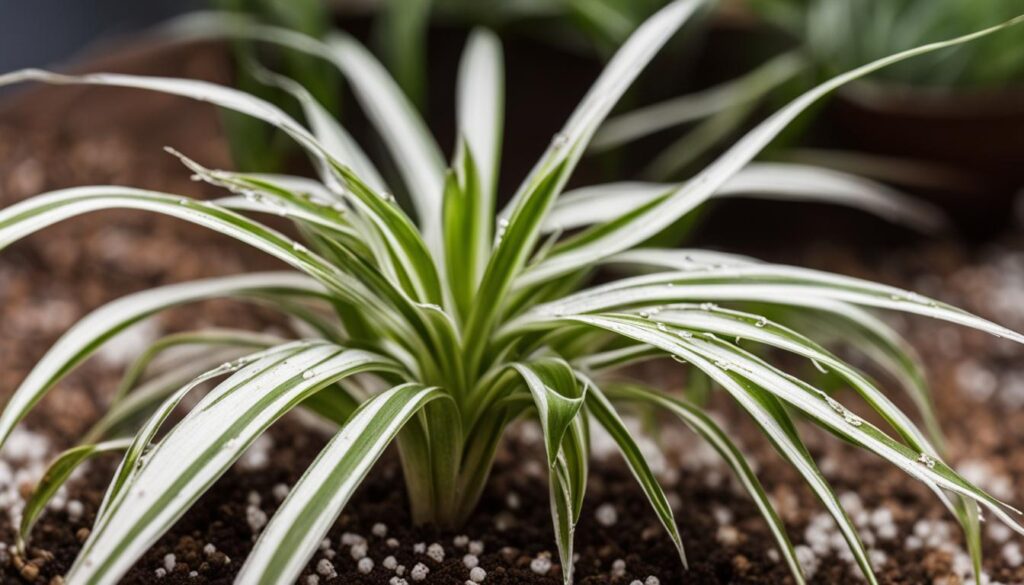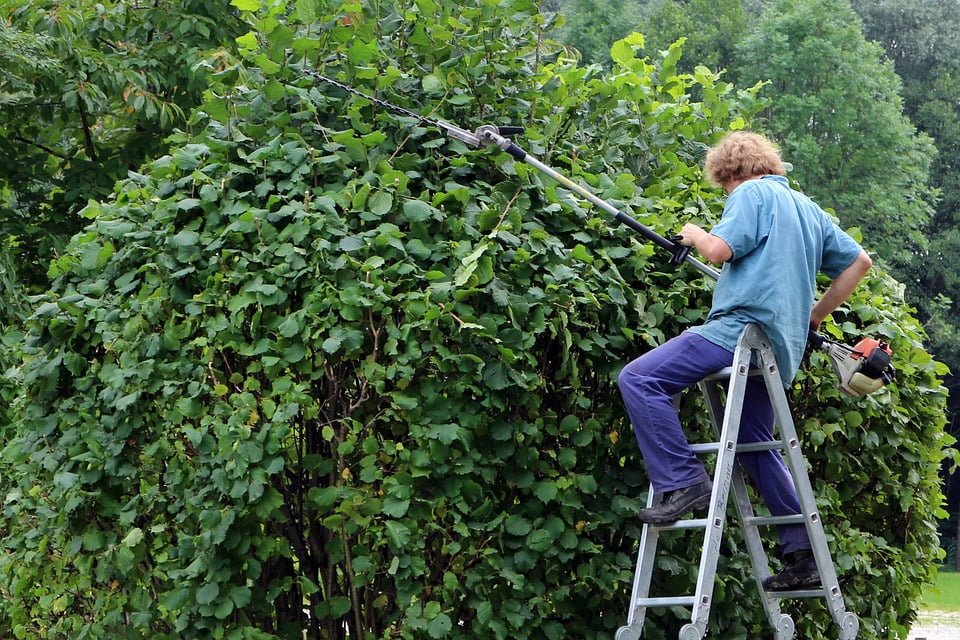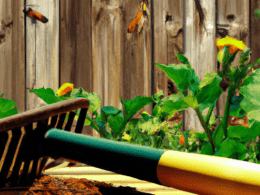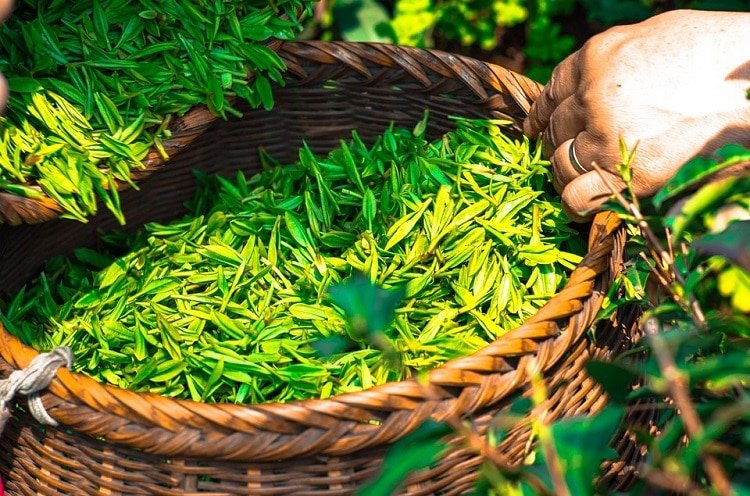The beautiful and resilient spider plant is a popular choice for indoor gardening due to its minimal care requirements and rapid growth. However, sometimes this forgiving plant may send out a distress signal in the form of crispy leaf tips or spider plant brown tips. If you’re wondering what might be causing this unwelcome change, worry not. We’ve got you covered with a comprehensive guide to understanding and addressing the root causes of brown tips on your spider plant.
Key Takeaways
- Identify the cause of brown tips, such as direct sunlight, low humidity, or inconsistent watering practices.
- Adjust your spider plant care routine to prevent further damage and promote healthy growth.
- Provide your spider plant with the right balance of light exposure by avoiding harsh direct sunlight and opting for bright, indirect light.
- Maintain optimal humidity levels by using techniques like misting or employing humidity trays.
- Establish a regular watering schedule, ensuring the plant’s soil doesn’t become too dry or waterlogged.
- Consider using filtered water or rainwater if brown tips persist, to address potential fluoride toxicity.
- Avoid excessive fertilization by using only half the recommended amount, and limit applications to the growing season.
Understanding Spider Plant Brown Tip Basics
Brown tips on spider plant leaves are a common indication of stress or environmental imbalance. This may occur due to various factors, including too much direct sunlight, low humidity, improper watering, fluoride toxicity, or issues related to over-fertilization. Identifying the correct cause is essential for addressing the problem, and although the brown tips themselves cannot be reversed, adjusting care practices can prevent further damage and promote healthy growth.
Let’s take a closer look at some of the causes of spider plant brown tips, and how you can address these issues to promote healthier growth for your houseplant:
- Too much direct sunlight
- Low humidity
- Improper watering
- Fluoride toxicity
- Over-fertilization
Below is a table outlining the causes, symptoms, and corrections for each of these issues:
| Cause | Symptoms | Correction |
|---|---|---|
| Too much direct sunlight | Scorched leaves, brown tips | Move to a location with bright, indirect light or filter the sunlight |
| Low humidity | Dry, crispy leaf tips | Use a humidifier, mist the leaves, or group with other plants to increase humidity |
| Improper watering | Wilted leaves, yellowing, brown tips | Ensure proper watering schedule and sufficient drainage |
| Fluoride toxicity | Brown tips with a yellow halo | Use rainwater or filtered water for watering and flush soil occasionally |
| Over-fertilization | Brown tips, stunted growth | Flush soil with water, reduce fertilizer usage, and follow recommended application rates |
By carefully observing your spider plant leaves turning brown, you can identify the root cause and make the necessary adjustments in your houseplant care practices. Remember, prevention is the best way to maintain a healthy and vibrant spider plant. So, ensure that your spider plant is getting the proper care and environment it needs to thrive.
Light Exposure: Sunlight vs. Shade for Spider Plants
One of the critical factors in maintaining a healthy spider plant is providing the appropriate light exposure. Spider plants have unique sunlight requirements that differ from many other houseplants. Understanding these needs will help ensure that your spider plant thrives in its environment, without suffering from leaf scorch or direct sunlight damage.
The Risks of Too Much Direct Sunlight
Although spider plants love bright environments, exposing them to too much direct sunlight can cause various problems. Direct sunlight can lead to leaf scorch and fading color, eventually resulting in brown, crispy leaf tips. Prolonged exposure to direct sunlight may also put the plant at risk of drying out, especially during hot summer months. Thus, it is vital to control the amount of spider plant light exposure your plant receives.
Creating the Ideal Lighting Conditions
For optimal growth, spider plants require indirect sunlight in environments that mimic dappled sunlight. These plants fare exceptionally well in locations that do not receive harsh direct sunlight. To maintain the ideal lighting for spider plants, consider the following tips:
- Position your spider plant in a space away from direct sunlight, such as a spot near a north or east-facing window.
- If your home has limited options, use curtains or blinds to filter and soften the light that reaches your spider plant, simulating indoor plant lighting conditions.
- Occasionally rotate your spider plant to ensure even light exposure on all sides for balanced growth.
While it may seem counterintuitive, providing your spider plant with the right balance between sunlight and shade will result in a healthier, more robust plant, free from direct sunlight damage. By carefully considering your plant’s light exposure and environment, you can successfully prevent common issues like brown tips and enjoy a thriving spider plant in your home.
Humidity Levels and Your Spider Plant’s Health
Spider plants have a preference for humid environments, such as bathrooms or kitchens, and may experience adverse effects due to dry air. This issue becomes particularly relevant during winter when indoor heating can reduce humidity levels. To ensure optimum growth and prevent brown tips, it is essential to meet the spider plant humidity requirements by protecting them from the dry air effects that may compromise their overall health.
There are several easy-to-implement techniques to maintain ideal indoor plant humidity levels for spider plants:
- Group your spider plant with other humidity-loving plants to create a microclimate of increased humidity.
- Place a humidity tray filled with water and pebbles beneath your spider plant, allowing the plant pot to sit on the pebbles. As the water evaporates, it will naturally raise the humidity around the plant.
- Use a mister or spray bottle to mist your spider plant’s leaves with water a few times a week, ensuring consistent moisture levels.
- Invest in a humidifier to maintain a steady humidity level in the room where your spider plant is located.
| Method | Description | Pros | Cons |
|---|---|---|---|
| Grouping with other plants | Place your spider plant near other humidity-loving plants for a microclimate effect. | Easy to implement and helps all plants sharing the space. | Requires a collection of humidity-loving plants. |
| Humidity tray | Create a tray filled with water and pebbles; place the plant pot on top of the pebbles. | Low maintenance and visually appealing. | Requires regular refilling of water and occasional cleaning. |
| Misting | Mist the leaves of your spider plant with water a few times a week. | Quick and easy method to provide consistent moisture. | Requires regular attention and may lead to uneven moisture levels. |
| Humidifier | Use a humidifier to maintain a consistent humidity level in the room. | Provides even humidity for all plants in the room and requires minimal attention. | May require an investment in a humidifier device and additional energy consumption. |
By taking the necessary steps to ensure that your spider plant’s humidity requirements are met, you will be better equipped to provide a nurturing environment that promotes its healthy growth, prevents brown tips, and ultimately allows it to thrive as an attractive and lively addition to your indoor space.
Watering Practices: Finding the Right Balance
Brown tips on spider plants may indicate either overwatering or underwatering. It’s essential to identify these symptoms and rectify them to maintain a healthy spider plant. In this section, we will discuss the signs of both underwatering and overwatering and how to address these watering issues effectively.
Signs of Overwatering and Underwatering
- Underwatering symptoms: Underwatering is suggested by limp leaves and soil that dries out too quickly, especially in hot or dry conditions. The plant may appear dehydrated, and leaf tips can turn brown.
- Overwatering issues: Overwatering can lead to root rot, as roots that sit in excess water become unable to function properly, paradoxically causing dehydration. Leaves may also turn yellow, and the plant may give off a foul odor due to rotting roots.
How to Correct Improper Watering
To address spider plant watering issues, start by ensuring the plant is in a pot with sufficient drainage. Remove excess water from trays or saucers after watering, and implement a consistent watering schedule. Allow the top inch of soil to dry before watering again, and adjust watering frequency according to seasonal growth rates and environmental conditions.
| Season | Watering Frequency |
|---|---|
| Spring and Summer | Once a week or when the top inch of soil is dry |
| Fall and Winter | Every 2-3 weeks or when the top inch of soil is dry |
Monitoring the plant soil moisture helps in establishing a correct watering schedule. In doing so, you can successfully fix spider plant watering issues and prevent the occurrence of brown tips in the future.
Complications From Fluoride and Your Spider Plant
Fluoride toxicity in spider plants is a primary cause of brown leaf tips, which can occur as a result of using tap water for houseplants. Due to the potential for harmful fluoride accumulation in the soil, it’s important to understand the risks and ways to mitigate these issues in order to maintain the health of your spider plant.
The Problem: When fluoride is present in tap water, it can accumulate in a spider plant’s soil, hindering photosynthesis and leading to brown leaf tips. This becomes a visual symptom of the plant’s struggle and reveals the need for adjustments in the plant’s environment and care.
The Solution: To reduce fluoride toxicity, using rainwater or filtered water for watering is recommended. Alternatively, regularly flushing the soil with rainwater can alleviate the buildup of fluoride. Below are some effective methods to combat fluoride-induced complications:
- Collect rainwater for use in watering your spider plant. This natural water source is free of fluoride and other chemicals frequently found in tap water.
- Invest in a water filtration system to remove fluoride and other unwanted chemicals from your tap water before using it to water your houseplants.
- Flush the soil with rainwater or filtered water every few months. To do this, simply pour a large amount of water through the soil to help wash away excess fluoride and other harmful residues.
In conclusion, avoiding the use of unfiltered tap water for watering your spider plant is essential in preventing fluoride toxicity and its subsequent effects on your plant’s foliage. By utilizing rainwater or filtered water and flushing the soil regularly, you will decrease the likelihood of encountering brown leaf tips that result from fluoride accumulation.
The Impact of Over-fertilization on Spider Plants
Over-fertilization can manifest as brown tips on spider plant leaves, indicative of root damage and hindered nutrient uptake. Recognizing fertilizer burn and signs of over-fertilization is crucial to prevent further damage, with symptoms resembling those of fluoride toxicity. Adjusting your houseplant fertilizing practices can help you avoid harming your spider plant with excess fertilizer.
Recognizing Fertilizer Burn
It’s essential to be vigilant when it comes to detecting fertilizer burn in spider plants. Some signs of over-fertilization include:
- Brown, crispy leaf tips
- Yellowing or wilting leaves
- Root damage or decay
- Stunted growth
If you observe any of these signs, consider revising your fertilizing strategy, such as using a more diluted solution and reducing the frequency of application.
How to Flush Out Excess Fertilizer
If you suspect that your spider plant has been over-fertilized, flushing houseplant soil can help remove excess fertilizer and prevent further browning of leaf tips. Follow these steps to flush the soil:
- Place the spider plant in a sink or bathtub.
- Run lukewarm water gently through the plant’s pot, allowing the water to drain out, for at least 10 to 15 minutes.
- Let the plant drain for a few minutes before returning it to its usual location.
By flushing the soil, you help revitalize over-fertilized plants and minimize the risk of further damage. To prevent future issues with over-fertilization, follow these fertilizing guidelines:
- Use only half the amount of fertilizer typically recommended for spider plants.
- Fertilize during the growing season only, with no more than quarterly applications.
- Opt for organic or slow-release fertilizers to reduce the risk of burning plant roots.
By taking these precautions, you can promote healthy growth and avoid fertilizer burn in your spider plants.
Practical Solutions and Preventative Care
To maintain the health and appearance of your spider plant, it’s essential to address the factors contributing to the development of brown leaf tips. The following practical solutions focus on three critical areas: water quality for spider plants, indoor humidity for plants, and establishing an optimal watering routine.
Adjusting Your Water Source
Tap water can contain salts, fluoride, and other chemicals that harm sensitive houseplants like the spider plant. Switching to filtered water or letting tap water sit overnight before using it allows harmful elements to evaporate and can significantly reduce the risk of brown tips. Alternatively, using collected rainwater for watering your spider plant also ensures a chemical-free source for maintaining soil moisture.
Improving Ambient Humidity
Spider plants thrive in humid environments. By increasing plant humidity, you can create more favorable spider plant environmental conditions and prevent the occurrence of brown tips. Consider these methods for enhancing the surrounding humidity:
- Regularly mist the leaves to add moisture to the air.
- Use a pebble tray filled with water to increase humidity around your plant.
- Invest in a humidifier to maintain a consistent indoor humidity for plants throughout your home.
- Group plants together to create a microclimate with higher humidity levels.
Creating an Effective Watering Schedule
A crucial aspect of spider plant care is the establishment of a consistent and safe watering practice that maintains proper soil moisture. To create an optimal watering routine, follow the guidelines in the spider plant watering guide:
- Allow the top inch of soil to dry before watering your plant.
- Water your plant thoroughly, ensuring that water drains out of the pot’s bottom, and avoid letting your plant sit in water.
- Adjust the watering frequency according to the season and your home’s environmental conditions (higher frequency in summer and lower during winter).
- Inspect the soil moisture regularly to catch signs of either overwatering or underwatering.
- During dry spells or low humidity periods, soak the plant thoroughly and consider misting the leaves to help rehydrate it.
By following these practical solutions and preventative care measures, you can minimize the likelihood of brown tips on your spider plant while ensuring a healthy and lush growth.
Will Making My Spider Plant Bushier Help Prevent The Tips From Turning Brown?
Yes, making your spider plant bushier can help prevent the tips from turning brown. You can achieve this by learning how to make spider plant bushier through proper pruning and regular fertilizing. Trimming off leggy stems and propagating new plants can also help achieve a fuller, healthier spider plant.
Conclusion
Adopting proper spider plant maintenance strategies is essential to prevent brown tips and promote healthy growth. By paying attention to potential causes such as sun exposure, humidity levels, watering practices, fluoride content, and fertilizer use, you can ensure your spider plant remains vibrant and thriving.
While trimming brown tips is possible, it is important to remember that prevention is the best approach to caring for your spider plant. By providing the appropriate environmental conditions, your spider plant will flourish without the need for excessive intervention. Following these guidelines will help you develop a healthy spider plant care routine.
Ultimately, achieving a lush and vibrant spider plant comes down to understanding its specific needs and finding the right balance of light, water, humidity, and nutrition. By following these suggestions, you can confidently prevent brown tips and ensure your spider plant’s long-term health and beauty.






